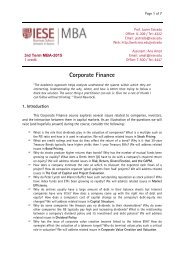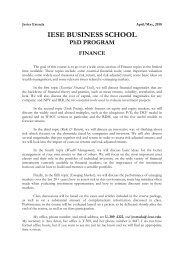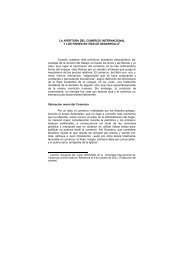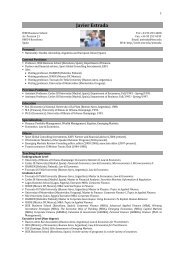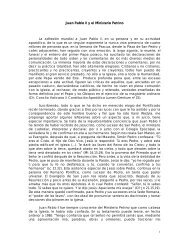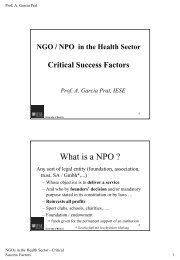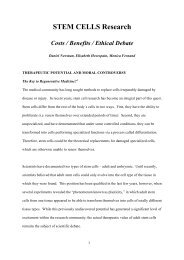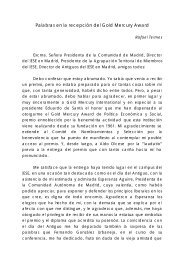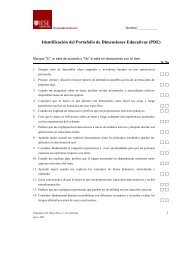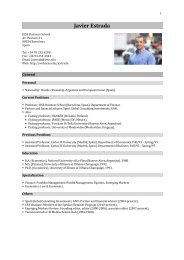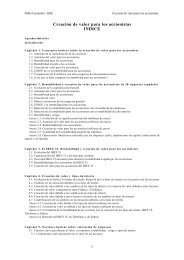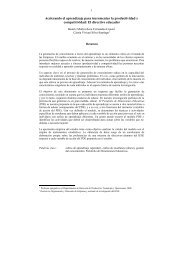GPOs and Advances Purchasing Mechanism - IESE Blog Community
GPOs and Advances Purchasing Mechanism - IESE Blog Community
GPOs and Advances Purchasing Mechanism - IESE Blog Community
Create successful ePaper yourself
Turn your PDF publications into a flip-book with our unique Google optimized e-Paper software.
or compulsory for the participant hospitals. Each year, a catalogue is developed with<br />
unified criteria by purchasing officers <strong>and</strong> by professionals, reaching today to 6.000-<br />
7.000 products. There is a unique supplier per product in 82%-83% of items. The tender<br />
consists of two phases: first, each hospital provides its needs <strong>and</strong> a tender is issued as<br />
the sum of needs with a maximum price (only technically correct suppliers will make it<br />
to the second phase); second, the ICS centralizes the tender <strong>and</strong> negotiates<br />
consumptions <strong>and</strong> prices with the suppliers. During the first years of the implementation,<br />
little hospitals were the most favoured by the system. Some of the main characteristics<br />
of this model are the following:<br />
- If more representativity is given to the users that consume the product the most, they<br />
will choose their usual supplier.<br />
- Professionals spend time evaluating products, not in their professional activity.<br />
- Some professionals do not consult the catalogue.<br />
- Another problem is the amount of time spent by professionals from different<br />
hospitals to decide what products are selected. This last problem will be solved in<br />
the future by creating a register system whereby for each product you have all the<br />
references from the product as of today available in the market, the supplier<br />
reference <strong>and</strong> its technical note. This new methodology makes sense for products<br />
with low differentiation relative to high-technological products.<br />
In some cases, this unique catalogue model has been institutionalized through a group<br />
purchasing organization (GPO), an entity that helps health care providers-such as<br />
hospitals -realize savings by aggregating purchasing volume <strong>and</strong> using that leverage to<br />
negotiate discounts with manufacturers, distributors <strong>and</strong> other vendors. In a more<br />
general sense, <strong>GPOs</strong> provide three essential functions for health care providers:<br />
- Aggregate buying power in order to obtain discounts from manufacturers <strong>and</strong><br />
distributors (strategic alliance, pool purchasing dollars to exert leverage over<br />
suppliers, concrete avenue for economies of scale, lower unit costs for members,<br />
negotiate & manage contracts).<br />
- Facilitate <strong>and</strong> enhance comprehensive product comparison analysis, using clinician<br />
input (update pricing changes, disseminate information from vendors under contract,<br />
cost reduction tools for members, benchmarking data).<br />
- Finally, they streamline <strong>and</strong> st<strong>and</strong>ardize the purchasing process, thereby reducing<br />
the inefficiencies inherent in today’s health care systems <strong>and</strong> offering valuable cost<br />
avoidance savings to providers (product st<strong>and</strong>ardization programs, product<br />
utilization programs, designate authorized distribution agents (ADAs), private label<br />
programs for smaller manufacturers).<br />
In the future, the next step for <strong>GPOs</strong> would be to assume the logistic function of the<br />
hospitals it serves <strong>and</strong> to exp<strong>and</strong> its services through Internet.<br />
-4-



